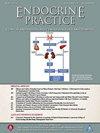免疫检查点抑制剂引起的垂体免疫相关不良事件的风险:系统回顾和荟萃分析
IF 4.6
3区 医学
Q2 ENDOCRINOLOGY & METABOLISM
引用次数: 0
摘要
免疫检查点抑制剂(ici)诱发的垂体炎是常见的内分泌免疫相关不良事件(irAEs)之一。我们的目的是评估脑内注射引起的垂体irae的风险。检索PubMed、Embase和Cochrane图书馆自成立至2024年10月31日的相关文献。根据纳入和排除标准筛选参考文献,提取研究资料。采用Revman5.3和Stata18.0软件进行meta分析。共纳入21项前瞻性单臂试验和17项随机对照试验(rct)。单组试验中,CTLA-4引起的垂体炎(4.00%)和垂体功能减退(3.84%)发生率以单药组最高,PD-1 + CTLA-4引起的垂体炎发生率以ICIs联合治疗组最高(9.36%)。在rct中,ICIs引起垂体irae的风险高于对照组(RR=10.09, 95%CI 6.90 ~ 14.75)。与单药治疗相比,ICIs联合治疗发生垂体irAEs的风险更高(RR=5.42, 95%CI 3.36-8.73)。在单药治疗中,CTLA-4引起的垂体炎和垂体功能减退的发生率最高,分别达到16.17%和1.75%。此外,CTLA-4引起的垂体不良ae的严重程度也最高(单组试验5.12%,随机对照试验16.35%)。结果显示,ICIs与垂体irAEs的风险显著升高相关,且ICIs联合使用可能进一步增加风险。在单药治疗中,CTLA-4引起垂体irAEs的发生率和严重程度最高,而PD-L1引起的发生率和严重程度最低。在联合治疗中,PD-1联合CTLA-4导致更高的垂体炎发生率。本文章由计算机程序翻译,如有差异,请以英文原文为准。
Risk of Pituitary Immune-Related Adverse Events Caused by Immune Checkpoint Inhibitors: A Systematic Review and Meta-Analysis
Objectives
Immune checkpoint inhibitor (ICI)-induced hypophysitis is one of the common endocrine immune-related adverse events (irAEs). Our goal is to evaluate the risk of pituitary irAEs caused by ICIs.
Methods
The relevant literatures were retrieved from PubMed, Embase, and Cochrane Library from inception to October 31, 2024. References were screened according to inclusion and exclusion criteria, and study data were extracted. Meta-analysis was performed using Revman 5.3 and Stata 18.0 software.
Results
A total of 21 prospective single-arm trials and 17 randomized controlled trials (RCTs) were included. In single-arm trials, the incidence of hypophysitis (4.00%) and hypopituitarism (3.84%) caused by cytotoxic T-lymphocyte-associated protein 4 (CTLA-4) inhibitors was the highest in monotherapy, and the incidence of hypophysitis caused by programmed cell death 1 (PD-1) inhibitors plus CTLA-4 inhibitors was the highest in ICI combination therapy (9.36%). In RCTs, the risk of pituitary irAEs caused by ICIs was higher than that of the control group (relative risk = 10.09, 95% CI: 6.90-14.75). Compared with monotherapy, ICI combination therapy has a higher risk of pituitary irAEs (relative risk = 5.42, 95% CI: 3.36-8.73). In monotherapy, CTLA-4 inhibitors caused the highest incidence of hypophysitis and hypopituitarism, reaching 16.17% and 1.75%, respectively. Furthermore, the severity of adverse pituitary irAEs caused by CTLA-4 inhibitors was also the highest (5.12% in single-arm trials, 16.35% in RCTs).
Conclusions
The results showed that ICIs are associated with a significantly higher risk of pituitary irAEs, and ICI combination may further increase the risk. In monotherapy, CTLA-4 inhibitors caused the highest incidence and severity of pituitary irAEs, while PD-L1 inhibitors caused the lowest. In combination therapy, PD-1 inhibitors combined with CTLA-4 inhibitors resulted in a higher incidence of hypophysitis.
求助全文
通过发布文献求助,成功后即可免费获取论文全文。
去求助
来源期刊

Endocrine Practice
ENDOCRINOLOGY & METABOLISM-
CiteScore
7.60
自引率
2.40%
发文量
546
审稿时长
41 days
期刊介绍:
Endocrine Practice (ISSN: 1530-891X), a peer-reviewed journal published twelve times a year, is the official journal of the American Association of Clinical Endocrinologists (AACE). The primary mission of Endocrine Practice is to enhance the health care of patients with endocrine diseases through continuing education of practicing endocrinologists.
 求助内容:
求助内容: 应助结果提醒方式:
应助结果提醒方式:


